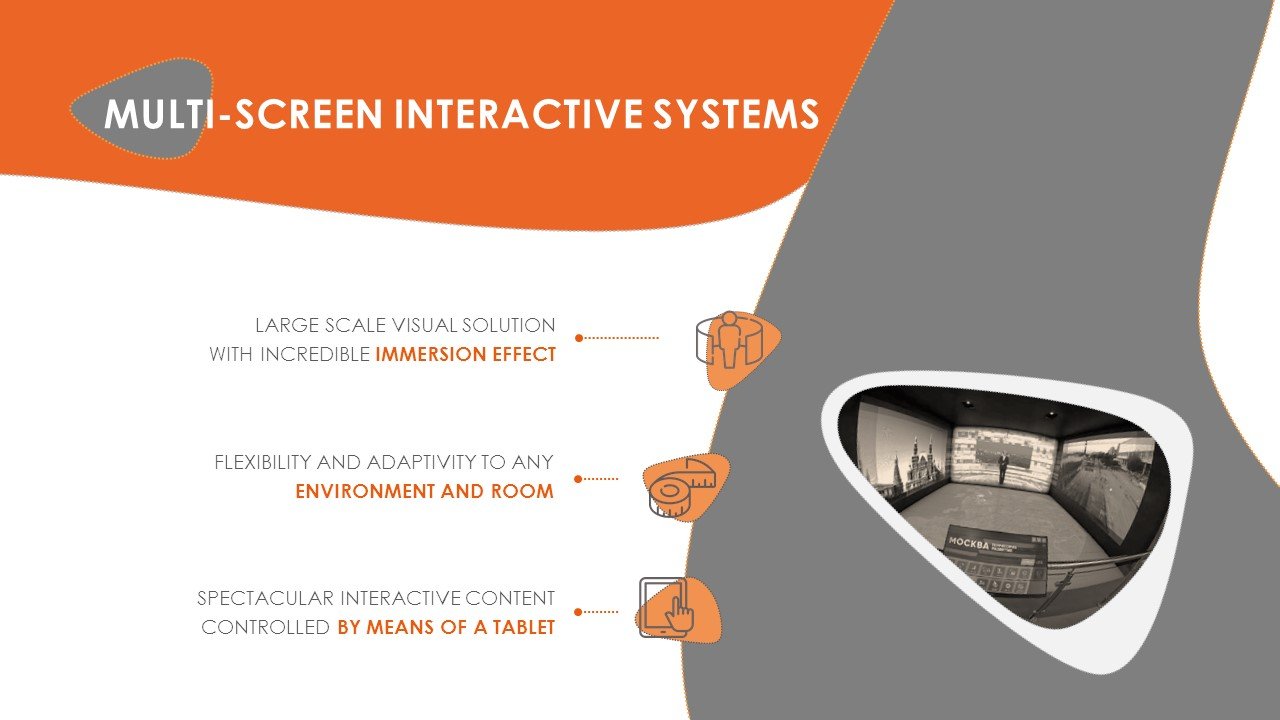MULTI-SCREEN INTERACTIVE SYSTEMS
Imagine having an installation that contains numerous LCD monitors, several displays, the projection onto the floor and walls, where some displays are horizontally oriented, others are placed vertically, some are small, even tiny, while the others are huge. All those different screens and displays are managed by just one system. All of them form a unite interactive space.
Innovative and expensive, complex and amazingly WOW effective, informative and easy to follow, – these are multi-screen interactive systems.
THE FORM
Depending on the location of the installation and the format of an event, such screens can be arranged linearly. This allows to expand the space visually by linking all the screens into a single unity.
Screens can also be positioned at a wide angle to each other, so that an observer “plunges” into the content demonstrated on the screens. Experts in the field of cognitive psychology argue that such an immersive effect significantly activates the mental processes of an observer, aggravates his perception, and immerses him into the content. One of a great examples of such immersive systems is the installation in the pavilion "Layout of Moscow" at VDNH, Moscow where the video content was created by our specialists.
However, linear multi-screen systems are certainly not the limit. A multi-screen system is a flexible solution that makes it possible to combine screens of different sizes and different display technologies. For example, you can sew three video walls and two projectors for video mapping (projection onto a real architectural model) and immerse an observer into a dynamic life of the huge metropolis, as it was realized for the exhibition stand of the Moscow Construction Complex at one of the major urban exhibitions.

THE CONTENT
The main ingredient of any installation is, of course, the content. Exciting, dynamic, with vivid animations and 3D effects, with synchronization of images on all screens of the system and a unifying control system.
Multi-screen systems have special design requirements – it is important to correctly “distribute” the given content across and along the screens, identifying the main and auxiliary displays, building a harmonious composition of the video sequence for the entire system.
Our company’s specialists can design such turnkey solutions, taking up on both the technical aspect of the project and the content development. When creating such installations, we first design a virtual prototype of the system in a 3D graphical editor. In a three-dimensional scene virtual displays, cameras and projectors (light sources) are placed, then a virtual observer (a user) is put into the scene. And through his virtual eyes the whole scene is analyzed from all angles.
Then we 'fit' these intermediate results onto a panoramic installation prototype where we can view the live content on the the screens in virtual reality. This allows to see the system from various angles, evaluate what will fall into the field of view of a real user, and calculate the speed of movement of all animated objects onscreen. And, of course, check the readability of the text and infographics. For such preview we use autonomous HMDs.
Based on the results of the final virtual “fitting”, we create the list of recommendations on the size of the screens as well as their relative arrangement onsite. Unlike digital signage, we make our content fully interactive, when the observer himself can choose what and when he wants to watch and experience.
Content management can be carried out using a usual touch screen, or gestures (Microsoft Kinect), through a tablet or a special 3D Pointer control device.